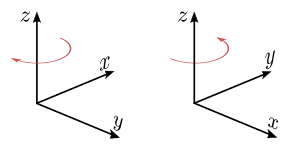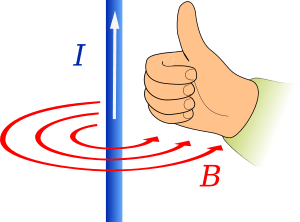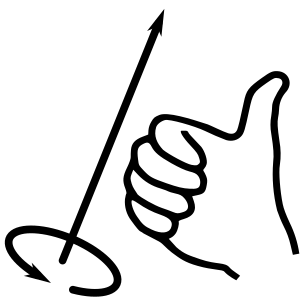Right-hand rule facts for kids
The right-hand rule is a helpful trick used in science and mathematics to figure out directions. It's especially useful when you're working with vectors, which are things that have both a size and a direction, like how fast something is moving and in what way. This rule helps you understand the direction of a new vector that comes from combining two other vectors.
To use the basic right-hand rule:
- First, hold out your right hand.
- Point your thumb straight up.
- Point your pointer finger straight forward.
- Now, stick out your middle finger so it points to the left. Make sure all three fingers (thumb, pointer, middle) are at right angles to each other, like the corners of a box.
If you have two vectors you want to combine (this is called a "cross product"), you can use your hand to find the direction of the new vector. Point your thumb in the direction of the first vector. Then, point your pointer finger in the direction of the second vector. Your middle finger will then show you the direction of the new vector that results from combining them!
It's important to remember that the order matters! If you swap the first and second vectors, the new vector will point in the exact opposite direction. So, always make sure you match your thumb to the first vector and your pointer finger to the second.
Other Ways to Use the Rule
There's another version of this rule called the right-hand grip rule (or sometimes the corkscrew rule). This one is often used for understanding magnetic fields and things that rotate or spin.
To use the right-hand grip rule:
- Start by holding out your right hand flat.
- Point your thumb straight out, away from your other fingers.
- Now, curl your other fingers into a fist, but keep your thumb sticking out (like you're giving a "thumbs up").
This rule helps you connect a straight direction with a spinning or curling direction. Imagine something is spinning or rotating. If you match the way your fingers curl to the direction of that spin, your thumb will point in the direction of the main vector that describes that spin.
You can also use this rule in reverse. If you know the direction of a straight vector, like the flow of electric current in a wire, you can point your thumb in that direction. Then, the way your fingers naturally curl will show you the direction of the magnetic field that forms around the wire. It's like turning a screw – the direction you turn the screw (your fingers) makes it move forward or backward (your thumb).
Images for kids
See also
 In Spanish: Regla de la mano derecha para niños
In Spanish: Regla de la mano derecha para niños






